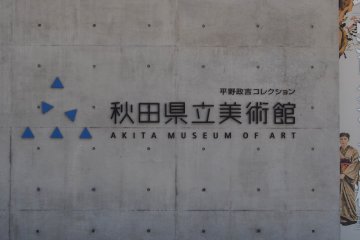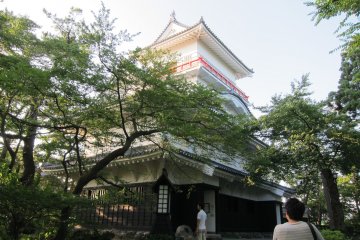When one speaks of Léonard Foujita, or Tsuguharu Fujita as he is known in Japan, the image that often comes to mind is that of a cosmopolitan painter who conquered the Paris art world of the 1920s. In France and other French-speaking regions, he is remembered as a beloved member of the École de Paris, a circle of foreign-born artists who brought fresh perspectives to modern art. His reputation there was firmly established through his refined technique and his instantly recognizable “milky-white nudes.” He has also been referred to as “the most important Japanese artist working in the West during the 20th century.” Yet for all of his success abroad, some of his best works, especially the monumental mural, The Events of Akita, remain hidden treasures found only in Japan—in Akita.
Fujita had the world at his feet. Paris, Tokyo, any great city could have been the canvas for his grand vision. So, why Akita? It’s a fair question and part of the answer lies with Masakichi Hirano, a local businessman and art collector, who commissioned one of his best works. But it wasn’t just about patronage. By the 1930s, Fujita had left behind the Paris spotlight, searching instead for depth. Akita, with its traditions and seasonal rhythms, offered that grounding. Here, he painted not only the life of a region but also a chapter of his own journey beyond fame.

Who Was Fujita?
Fujita was born in Tokyo in 1886 and trained under Kuroda Seiki at the Tokyo School of Fine Arts (now Tokyo University of the Arts). But by 1913, his sights were set on Paris, the beating heart of modern art. In Montparnasse, he quickly became part of the buzzing École de Paris, mingling with Modigliani, Chagall, Kisling, and other legends.
The 1920s were his golden years. His famous “milky-white nudes” made him a star at the Salon. He painted cats, still lifes, and portraits that felt both modern and timeless. Yet even as he basked in success, he remained an outsider, as a Japanese artist in Europe, carving out his own space between two cultures.
Later, history pulled Fujita back to Japan during World War II, where he created war record paintings before eventually returning to France in 1950. There, he reinvented himself once more—by becoming a French citizen in 1955 and embracing Catholicism in 1959. In his final years, he turned his hand to religious art. His ultimate creation was the serene Foujita Chapel in Reims, a jewel of spiritual devotion.
Evolution of Style and Themes: War, Prayer, and Figures
Fujita’s career can be divided into distinct phases, each reflecting both his personal journey and the broader currents of the time:
Early Period (1910s–1920s) - Fujita’s Paris years were defined by his success with nudes, portraits, and still lifes. Works set in the Luxembourg Gardens displayed fine contour lines, pale palettes, and flat compositions. Before fully adopting the francized “Foujita,” he often signed his early paintings simply as “Fujita.”
Middle Period (1930s–1940s) - His return to Japan coincided with darker years. His paintings from this period include large-scale war documents and group portraits marked by greater realism, stronger shadows, and a heavier atmosphere.
Late Period (1950s–1960s) - In his later years, Fujita’s conversion to Catholicism shifted his attention to sacred themes. He produced murals and frescoes that merged traditional Western religious iconography with his uniquely precise Japanese line, and it was here that the Foujita Chapel was born.
Despite these shifts, several features persisted throughout: his meticulous detail, his penchant for narrative composition, and above all his hybrid aesthetic that is simultaneously Japanese and Western, modern and classical.
What Is The Events of Akita?
The Events of Akita came to life thanks to Masakichi Hirano, a local businessman and art lover who asked Fujita to create something truly special for his hometown in 1937. The mural is massive and stretches over 20 meters long and about 3.6 meters high. It unfolds as a sweeping panorama of Akita’s folk life and festivals, carrying the seasons in one continuous story. Spring bursts to life with lively celebrations, summer glows with the lanterns of the famous Kanto Festival, autumn fills the canvas with markets.
Fujita ties all the Japanese seasons together with his signature touch: that gives clarity to every figure, a subdued color palette that softens the mood, and a scroll-like rhythm that guides the eyes seamlessly from one season to the next.
Why The Events of Akita Is a Must-See Masterpiece
The Events of Akita stands out as the largest painting Fujita ever created. He fused Western oil painting with Japanese narrative traditions, creating a mural that feels both global and deeply local. Beyond its artistry, the mural holds powerful historical weight. It captures the rhythms of everyday life in pre-war Akita with striking, almost documentary precision, while also marking a turning point in Fujita’s career.
What makes it truly special, though, is its cultural heart. Fujita painted Akita’s festivals and customs with genuine respect, offering the perspective of an outsider who saw beauty in the details locals might have overlooked. And today, you can still experience the mural exactly where it was born—at the Akita Museum of Art, in a calm, contemplative space designed to let the painting breathe and astonish.
Experiencing It at the Akita Museum of Art

Visiting The Events of Akita is also about experiencing it in the space designed to honor it. The Akita Museum of Art, created by world-famous architect Tadao Ando, feels like a work of art in itself. Outside, a striking water garden reflects the sky and offers peaceful views of Senshu Park. Inside, a sweeping spiral staircase, built without a central pillar, will welcome you beneath a striking triangular skylight at the building’s entrance.

While the mural is the star, the museum has much more to explore. Masayoshi Hirano Collection includes Fujita’s self-portraits, sketches, and smaller works that give a more personal glimpse of the artist. Rotating exhibitions also bring in modern and contemporary art from Japan and abroad, making the museum a lively hub for culture as well as history.
A Journey Where Art, Memory, and Time Intersect
The Events of Akita is the story of how a celebrated painter found inspiration far from the world’s art capitals. Created at the height of Fujita’s career, it remains firmly anchored in Akita, the place that gave it meaning. It also reflects an exchange between France and Japan, a moment when a Paris-trained artist turned his gaze to the festivals, seasons, and soul of rural Japan. It shows how art can travel across borders yet still root itself deeply in local culture.

For travelers who crave more than surface-level sightseeing, this mural offers a powerful reason to come to Akita. Standing before it, you can connect with Akita’s traditions, people, and landscape through Fujita’s eyes—an experience of art, memory, and place found nowhere else. And getting there couldn’t be simpler: the museum is a 10-minute walk from JR Akita Station or about 40 minutes by bus from Akita Airport.










